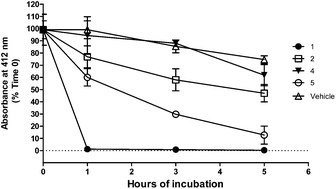High throughput glutathione and Nrf2 assays to assess chemical and biological reactivity of cysteine-reactive compounds
Abstract
Compounds that inhibit their target through covalent binding offer a number of unique advantages as potential therapeutic agents. They can achieve high ligand efficiency, and thus high potency, which can translate into a reduced drug dosage. In addition, covalent binding can result in a long duration of action of the compound and thus less frequent drug dosing. Despite these advantages, there are several safety concerns about this class of compounds because of their inherent reactivity and potential for non-specific binding to cellular proteins. The primary aim of this study was to establish the thiol reactivity of acrylamides and other cysteine-reactive groups by measuring reactivity against various cysteine-containing cellular components. Compounds were incubated with glutathione, bovine serum albumen (BSA) or human liver microsomes (HLM), and the reduction in thiol levels was quantitated using Ellman's reagent. In addition, the ability of compounds to induce Nrf2 activity in a reporter gene assay was used as a functional readout of compound reactivity. The assays were validated using known thiol-reactive compounds and Nrf2 inducers such as sulforaphane (SFP) and 1,2-dithiole-3-thione (D3T). Our results demonstrate that acrylamides possess low reactivity unless activated by electron-withdrawing N-substituents. Analogous propynamides and vinyl sulphones were more reactive than acrylamides with respect to glutathione activity but were less reactive in the Nrf2 assay. Large drug-like molecules, including irreversible kinase inhibitors targeting BTK and EGFR, were far less reactive than their lower molecular weight counterparts, suggesting that the presence of an electrophile is not sufficient to predict thiol reactivity. These studies demonstrate the utility of multiple thiol sources in addition to glutathione when assessing the thiol reactivity of covalent inhibitors.


 Please wait while we load your content...
Please wait while we load your content...